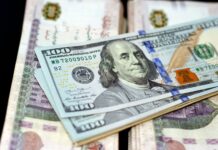July 25, 2019
The International Monetary Fund (IMF) plans to discuss the fifth and final review of the Egyptian economy and vote for the sixth and final tranche of the loan, which is $2 billion.
According to forecasts, Egypt will receive the final installment of the IMF loan “at the end of next week or at the beginning of the last week of this month at the latest.”
Egypt agreed with the IMF in November 2016 on a $12 billion, 3-year loan programme linked to broad fiscal policy reforms.
Over the past three years, the IMF has disbursed the loan in six segments and each time reviewed the economic reform measures in accordance with the agreement.
The IMF has approved the disbursement of every previous tranche of the loan, which means it agreed to the financial procedures and policies adopted by Cairo. Although the IMF approved the economic measures taken by Cairo, it is difficult to say that life for Egyptian people has got better.
Unaffordable prices
In a country that depends on imports, the price of the dollar against the Egyptian pound is a key factor in determining the price of most commodities. Prior to Cairo’s economic reform and the liberalisation of the exchange rate in November 2016, the price of the US dollar against the Egyptian pound reached about EGP 8. A few days before the last tranche of the IMF loan, the dollar was worth around EGP 17.
Egypt has experienced unprecedented price increases over the past years, and commodity price increases have not matched increases in salary and wage rates.
Fuel prices are an indication of how high prices are in Egypt. For example, the price of the lowest priced 80 per cent gasoline used by the majority of Egyptian people rose from EGP 1.6 ahead of the economic reform decisions to EGP 6.75 before the last tranche of the IMF loan.
Other fuel segments saw similar increases, raising the price of all goods prices, because of their dependence on fuel for transport, conservation or production.
Spiking governmental debt
The news of economic reform was not all bad. Egypt’s foreign exchange reserves rose from $17 billion in June 2016 to $44 billion in March 2019, but even that good news was not true, as economists have revealed.
The increase in foreign currency reserves was just debts and deposits which hinder the Egyptian economy. The Central Bank of Egypt (CBE) announced on May 22 2019 that the country’s total domestic debt increased by 20.25 per cent year-on-year to EGP 4.108 trillion ($241.9 billion) at the end of December 2018.
The country’s external debt grew 16.6 per cent year-on-year to about $96.6 billion. According to data from the Egyptian Finance Ministry, the amount of debt interest amounts to EGP 541 billion pounds ($30.4 billion). In contrast, the benefits of Egyptian debt reached EGP 243.6 billion ($13.6 billion) in mid-2016.
Loans without development
The Egyptian government says that current savings have been channeled from the abolition of fuel and commodity subsidies to health and education, but government figures and World Bank reports say this is incorrect. Egyptians are suffering from high prices and declining purchasing power.
The World Bank said in a report on Tuesday that the health and education sectors in Egypt “have not benefited from the savings of the government’s financial reforms over the past years.” The report mentioned a decline in the allocation of health care and education in the state budget compared to the real value.
The Egyptian budget for the fiscal year 2019-2020 violated the provisions of the constitution for the fourth consecutive year in relation to the commitment of the state to allocate a proportion of government expenditure of not less than 10 per cent of the gross national product to the sectors of health, education, higher education and scientific research.
The budget, which began on July 1, allocated for these sectors together about EGP 206 billion out of the value of the gross national product of EGP 6.2 trillion, that is about 3.3 per cent.









